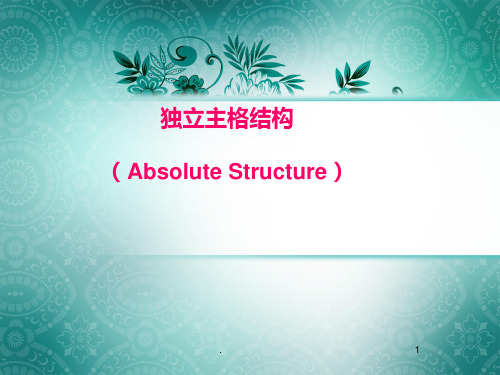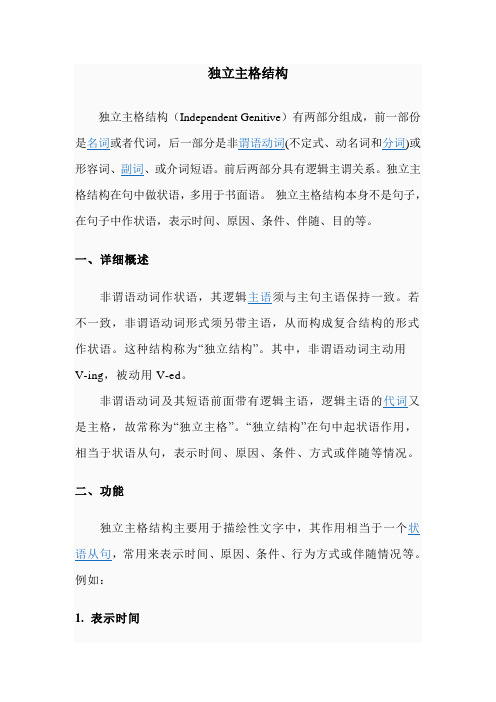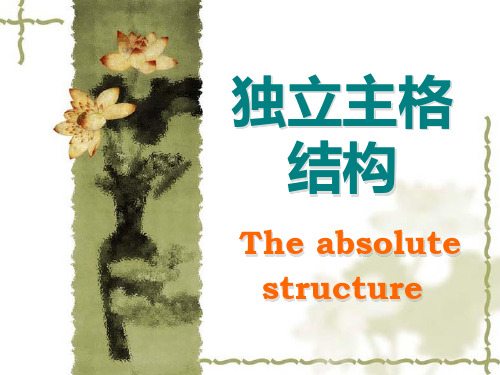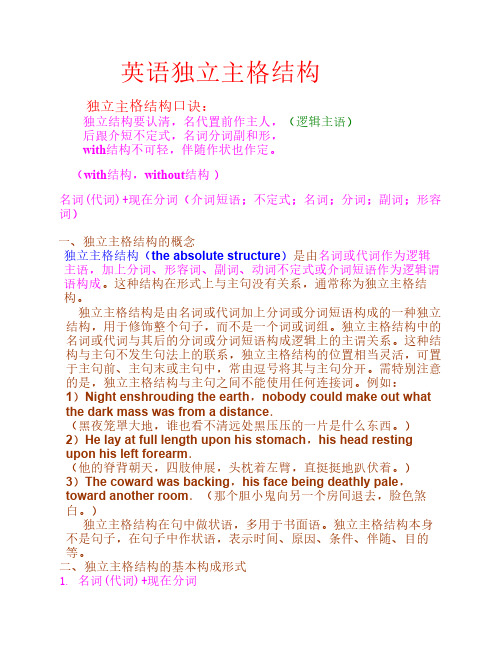独立主格结构ppt.
独立主格PPT课件

☞ Lunch over, he left the house. But he was thinking..
.
16
③ 名词/代词+现在分词
☞ Winter coming, it gets colder and colder. 冬天 来了,天气越来越冷了。
.
14
There being+名词: there being nothing else to do, we
went home
名词(代词)+不定式:She proposed a picnic, she
herself to pay the railway tickets, and Mary to provide
☞ It raining, I stayed at home.
.
4
比较三句:
☞ It rained so/and I stayed at home. ☞ Because it rained yesterday, I stayed at home. ☞ It raining, I stayed at home.
☞ The question being settled, we wound up the meeting. 问题解决之后,我们结束了会议。
☞ The rain having stopped, he went out for a walk. 雨停了,他出去散步。
.
④ 名词/代词+过去分词
the food.
名词(代词) +介词短语: the teacher entered the
非谓语动词与独立主格结构.ppt

非谓语动词 & 独立主格结构
By Gordon
一、非谓语动词 1. 定义: 在句子中充当除谓语以外的句子成分的动词形 式叫做非谓语动词,它不受人称和数的限制。
返回
二、形式:
省略to的情况:
1. 在使役动词和感官动词后:(一感二听三看四让) feel / hear, listen to / loot at, see, watch / let, make, have, get
2. had better (not) do sth. 最好(不)做。。。 3. why not / why don't you do sth. 为什么不做。。。? 4. help sb. (to) do sth. 5. would rather do...宁愿做。。。 6. would you (please) do ... 情态动词 + do; 助动词 + do
独立主格特点: A: 用逗号 “,” 与主句分开,没有 “and”。 B: 介词with可省。 C: 在句中作状语,可改为相应的状语从句。
With one more chance given, I will make it. (独立主格)
If I am given one more chance, I will make it. (状语从句)
区别: Remember / forget / + doing(to do) Stop + doing (to do) Go on + doing (to do) Try + doing (to do)
Hale Waihona Puke 二、独立主格形式:
1. With + N + adj. 2. With + N + adv. 3. With + N + prep. 4. With + N + doing 重点 5. With + N + done 重点 6. With + N + to do 重点
独立主格PPT课件

.
10
4. 名词(主格代词+形容词
An air accident happened to the plane,nobody alive. 那架飞机遭遇了空难,无一人生还。
So many people absent, the meeting had to be called off. 这么多人缺席,会议不得不取消。 Computers very small, we can use them widely.
The four of us agreed on a division of labor, each to translate a quarter of the book.
我们四人同意分工干,每人翻译全书的四分之一。
Many trees, flowers, and grass to be planted, our newlybuilt school will look even more beautiful.
A. had been fulfilled B. were fulfilled C. having been fulfilled D. been fulfilled
.
4
独立主格结构
一. 概念 二. 构成形式 三. 句法功能 四. 特点 五. 注意事项
.
5
一、独立主格结构的概念
独立主格结构(Absolute Structure )有 两部分组成,前一部份是名词或者代词,后 一部分是非谓语动词(不定式、动名词和分词) 或形容词、副词、或介词短语。前后两部分 具有逻辑主谓关系。独立主格结构在句中做 状语,多用于书面语。 独立主格结构本身不 是句子,在句子中作状语,表示时间、原因、 条件、伴随、目的等。
独立主格结构

独立主格结构独立主格结构(Independent Genitive)有两部分组成,前一部份是名词或者代词,后一部分是非谓语动词(不定式、动名词和分词)或形容词、副词、或介词短语。
前后两部分具有逻辑主谓关系。
独立主格结构在句中做状语,多用于书面语。
独立主格结构本身不是句子,在句子中作状语,表示时间、原因、条件、伴随、目的等。
一、详细概述非谓语动词作状语,其逻辑主语须与主句主语保持一致。
若不一致,非谓语动词形式须另带主语,从而构成复合结构的形式作状语。
这种结构称为“独立结构”。
其中,非谓语动词主动用V-ing,被动用V-ed。
非谓语动词及其短语前面带有逻辑主语,逻辑主语的代词又是主格,故常称为“独立主格”。
“独立结构”在句中起状语作用,相当于状语从句,表示时间、原因、条件、方式或伴随等情况。
二、功能独立主格结构主要用于描绘性文字中,其作用相当于一个状语从句,常用来表示时间、原因、条件、行为方式或伴随情况等。
例如:1. 表示时间The meeting being over, all of us went home. 开完会后我们都回家了。
Her work done, she sat down for a cup of tea. 她干完了活,坐下来喝茶。
2. 表示条件The condition being favourable, he may succeed. 若条件有利,他或许能成功。
3. 表示原因There being no taxes, we had to walk. 没有出租车,我们只好步行。
He wrapped her up with great care, the night being dark and frosty. 夜又黑又冷,所以他把她裹得严严实实的。
4. 表示伴随情况Almost all metals are good conductors, silver being the best of all. 几乎所有的金属都是良导体,而银则是最好的导体。
高考英语独立主格详细讲解.ppt

2)____D______, the train started.
A.After having given the signal B.After the signal given
open.
A.It being B.As it is C.Being D.A and B
3._D____, I had to ask for two days’ leave.
A.Mother being ill B.Bother ill C.As mother was ill D. A,B and C
二、独立主格结构在整句中可作以下成分:
1、原因状语 该结构在句中作原因A______ no bus, we had to walk home.
A.There being B.As there was C.There was D.A and B
2).___D______Sunday, the library doesn't
4)__D____Sunday, the library doesn't open. A.As it being B.Being C.It is D.As it is
2、逻辑主语+V-ed 该构成形式内部的逻辑主语是分词的动作承受者。
1)___A______, the train started.
A.There being B.Being
C.Having been D.There was
2)___B____no bus, we had to walk home. A.As there being B.As there was C.Being D.There was
高中英语独立主格结构(共26张PPT)

e.g. More money given, we should have sent more employees to the mother company to get trained.
2. 在独立主格结构中,如果强调分词 的时间发生在主句动词之前,常用 现在分词完成时态表示。
e.g. He stood there, his hand tied. 也可以用with的复合结构:
e.g. He stood there, with his hand tied.
独立主格结构使用介词的问题: 当介词是in时,其前后的两个名词 均不加任何成分(如物主代词或冠词), 也不用复数。 e.g. A robber burst into the room, knife in hand.
4. He (being) absent, no business was done.
5.She sat there alone, her face covered with her hands / her hands covering her face.
6.He was reading newspaper, (with) his back against the window.
The snow having stopped, she went out to the zoo.
The clock having struck 12, I went to bed.
The problem having been settled, we ended our meeting.
我们一起来改一下这个句子:
独立主格结构的用法
独立主格

7. There being +名词(代词)如: There being nothing else to do, we went home. 没有别的事可做,我们就回家了。 There being no further business, I declare the meeting closed. 没有再要讨论的事了, 我宣布散会。 8. It being +名词(代词)如: It being Christmas, the government offices were closed. 由于圣诞节的缘故,政 府机关都休息。 It being a holiday, all the shops were shut. 由于今天是假日,所有商店都关门了。
使用独立主格注意三Байду номын сангаас:
1. 不能省略being (having been)的情形 在下列两种情况下,独立主格结构中的 being(或having been)不能省略。 (1) 独立主格的逻辑主语是代词时。如: It being Sunday, we went to church.因为是星 期天,我们去了做礼拜。 (2)在There being+名词的结构中。如: There being no bus, we had to go home on foot.因为没有公共汽车,所以我们不得不 步行回家。
So many people absent, the meeting had to be called off.
2)名词/代词+现在分词
名词/主格代词与现在分词之间主谓关系
Winter coming,it gets colder and colder.冬 天来了,天气越来越冷了。 The rain having stopped ,he went out for a walk.雨停了,他出去散步。 姑娘两眼望着他,他不知道说什么好。 如果时间允许的话,我们明天去郊游。
独立主格结构

• 表示条件
• The condition being favourable, he
may succeed. 若条件有利,他或许能成功。
• 表示原因
• There being no taxes, we had to walk.
没有出租车,我们只好步行。
• He wrapped her up with great care,
thfrosty. 夜又黑又
冷,所以他把她裹得严严实实的。
• 表示伴随情况
• Almost all metals are good conductors,
silver being the best of all. 几乎所有的金
属都是良导体,而银则是最好的导体。 (=Almost all metals are good conductors, and silver is the best of all.)
• 名词/主格代词+过去分词
•
名词/主格代词与过去分词之间是动宾关系。如:
• The problems solved(= As the problems
were solved), the quality has been improved. 随着问题的解决,质量已经提高了。
• Her glasses broken(= Because her glasses
•独立主格结 构
独立主格结构(Independent Genitive)有两部 分组成,前一部份是名词或者代词,后一部分是 非谓语动词(不定式、动名词和分词)或形容词、 副词、或介词短语。前后两部分具有逻辑主谓关 系。独立主格结构在句中做状语,多用于书面语。 独立主格结构本身不是句子,在句子中作状语,
《独立主格结构》课件

名词/代词+不定式
例如,He lay on the bed,to rest.
with引导的独立主格结构
with+名词/代词+形容词
例如,With the weather fine,we decided to go out.
பைடு நூலகம்
with+名词/代词+副词
例如,With the children away,they had a peaceful weekend.
《独立主格结构》 PPT课件
目录
CONTENTS
• 独立主格结构的定义 • 独立主格结构的类型 • 独立主格结构在句子中的作用 • 独立主格结构的构成 • 独立主格结构的用法举例 • 独立主格结构与其它结构的辨析
01 独立主格结构的定义
什么是独立主格结构
01
独立主格结构是一种语法结构, 它由一个主语和一个谓语组成, 但主语和谓语之间没有连接词。
总结词
副词性独立主格结构是由副词或副词短语构成的,主要在句中作状 语。
详细描述
例如,“The book written by him is mine.”,其中“written by him”就是一个副词性独立主格结构,表示“这本书是他写的”。
03 独立主格结构在句子中的 作用
补充说明
总结词
独立主格结构用于对句子的主句进行补充说明,提供更多的细节或背景信息。
件等。
总结词
名词性独立主格结构是由名词或 名词短语构成的,主要在句中作
状语。
详细描述
例如,“The book in the library is mine.”,其中“in the library”就是一个名词性独 立主格结构,表示“这本书在图
高中英语语法______独立主格结构课件

(Ⅰ) 名词/代词+分词(过去分词done & 现在分词doing)
当分词作状语时,其逻辑主语与句子的主 语不一致时,分词应有自己的逻辑主语, 构成分词的独立结构。一般位于句首,也 可放在句尾;作伴随状语时,常放在句首。 1T._h_is__p_ro_b__le_m__s_e_t_tl_e_d, they left the meeting – room. (问题解决了)(settle) 2T._im__e_p_e_r_m__it_t_in_g,we`ll go there on foot. (时间允许的话)(permit) 3.He was lying on the grass,(他的手交叉在头下) his h_a_n_d_s__cr_o_s_s_e_d_u__n_d_e_r_h_i_s_h_e_a_d_._(cross)
(ⅤI) with/without+名词/代词+副词。
__ C
production up by 60%,
the company has had another excellent
year.
A. As B. For C. With D. Through
活学巧用
1.The square looks more
C 1. With a lot of difficult problems __
, the
newly-elected president is having a hard time.
A. settled B. settling
C. to settle D. being settled
2.因为有太多的作业要做,所以我们不能出去玩。
结构:
名词/代词 + 非谓语(doing & todo & done)
5-独立主格结构

英语独立主格结构独立主格结构口诀:独立结构要认清,名代置前作主人,(逻辑主语)后跟介短不定式,名词分词副和形,with结构不可轻,伴随作状也作定。
(with结构,without结构)名词(代词)+现在分词(介词短语;不定式;名词;分词;副词;形容词)一、独立主格结构的概念独立主格结构(the absolute structure)是由名词或代词作为逻辑主语,加上分词、形容词、副词、动词不定式或介词短语作为逻辑谓语构成。
这种结构在形式上与主句没有关系,通常称为独立主格结构。
独立主格结构是由名词或代词加上分词或分词短语构成的一种独立结构,用于修饰整个句子,而不是一个词或词组。
独立主格结构中的名词或代词与其后的分词或分词短语构成逻辑上的主谓关系。
这种结构与主句不发生句法上的联系,独立主格结构的位置相当灵活,可置于主句前、主句末或主句中,常由逗号将其与主句分开。
需特别注意的是,独立主格结构与主句之间不能使用任何连接词。
例如:1)Night enshrouding the earth,nobody could make out what the dark mass was from a distance.(黑夜笼罩大地,谁也看不清远处黑压压的一片是什么东西。
)2)He lay at full length upon his stomach,his head resting upon his left forearm.(他的脊背朝天,四肢伸展,头枕着左臂,直挺挺地趴伏着。
)3)The coward was backing,his face being deathly pale,toward another room.(那个胆小鬼向另一个房间退去,脸色煞白。
)独立主格结构在句中做状语,多用于书面语。
独立主格结构本身不是句子,在句子中作状语,表示时间、原因、条件、伴随、目的等。
二、独立主格结构的基本构成形式1. 名词(代词)+现在分词Night coming, he arrived home.There being no bus, we had to walk home. 由于没有公共汽车,我们只好走回家。
独立主格结构

独立主格结构独立主格结构(Independent Genitive)有两部分组成,前一部份是名词或者代词,后一部分是非谓语动词(不定式、动名词和分词)或形容词、副词、或介词短语。
前后两部分具有逻辑主谓关系。
独立主格结构在句中做状语,多用于书面语。
独立主格结构本身不是句子,在句子中作状语,表示时间、原因、条件、伴随、目的等。
目录详细概述功能用法形式特点注意事项示例详细概述功能用法形式特点注意事项示例展开编辑本段详细概述非谓语动词作状语,其逻辑主语须与主句主语保持一致。
若不一致,非谓语动词形式须另带主语,从而构成复合结构的形式作状语。
这种结构称为“独立结构”。
其中,非谓语动词主动用V-ing,被动用V-ed。
非谓语动词及其短语前面带有逻辑主语,逻辑主语的代词又是主格,故常称为“独立主格”。
“独立结构”在句中起状语作用,相当于状语从句,表示时间、原因、条件、方式或伴随等情况。
编辑本段功能独立主格结构主要用于描绘性文字中,其作用相当于一个状语从句,常用来表示时间、原因、条件、行为方式或伴随情况等。
例如:表示时间The meeting being over, all of us went home. 开完会后我们都回家了。
Her work done, she sat down for a cup of tea. 她干完了活,坐下来喝茶。
表示条件The condition being favourable, he may succeed. 若条件有利,他或许能成功。
表示原因There being no taxis, we had to walk. 没有出租车,我们只好步行。
He wrapped her up with great care, the night being dark and frosty. 夜又黑又冷,所以他把她裹得严严实实的。
表示伴随情况Almost all metals are good conductors, silver being the best of all. 几乎所有的金属都是良导体,而银则是最好的导体。
独立主格结构

七、非谓语动词独立主格结构 在独立主格结构中,非谓语动词和它前 面的名词或代词存在着逻辑上的主谓关系。 Such an able man to help you,you will surely succeed sooner or later. 有这么能干的人来帮你, 你迟早一定会成功 的。(such an able man和 to help you 之间 存在着主谓关系) = Since such an able man will help you, you will surely succeed sooner or later.
五、独立主格结构与分词短语作状语的异同: 1、独立主格结构与分词短语都可以转化成状语从句。 但是,独立主格结构转换成状语从句后,有自己的逻 辑主语,与主句的主语不一致;而分词短语转化为状 语从句后,从句的主语与主句的主语相同。例: ⑴ If time permits, we’d better have a rest at this weekend. -→Time permitting,we’d better have a rest at this weekend. 如果时间允许,本周末我们最好休息一下。 ⑵ When we see from the top floor, we can find the garden more beautiful. -→Seeing from the top floor, we can find the garden more beautiful. 从顶楼上看,花园更漂亮。
1.表示时间的-ing形式作“独立主格结 构” Everyone being ready, the teacher began his class. 每个人都准备好后,老师开始上课。 (相当于一个时间状语从句When everyone was ready) The chairman began the meeting , everyone being seated. 每个人坐好后,主席开始开会。 (相当于一个时间状语从句after everyone was seated)
高考英语语法独立主格结构精讲(共20张PPT)

The guard stood by the door, gun in hand.
注意:being在下列两种情况下一般不能省略: 1) “There being + 名词”结构中:
There being no bus, we had to walk home.
his best to prepare the dinner. 谓语动词之后
We redoubled our efforts, each man 主动 working like two. 与谓语动词同时在进行
The last bus having gone, we had to walk
home. 主动
构。
to do…
doing
done
with without
+
O
+
OC
n. adj.
adv.
prep-phrase
With so much work to do, I don’t know if I’ll have time to go out. The girl hid her box without anyone knowing where it was. With his homework finished, he went to see a film. The old man lives alone with the dog his only companion. He stood in the rain, with his clothes wet. With John away, we’ve got more room. Vincent sat at the desk, with a pen in his mouth.
《英语语法》独立主格结构

1. 名词(代词)+现在分词 There being no bus, we had to walk home. 由于没有公共汽车,我们只好走回家。
2. 名词(代词)+过去分词
He was listening attentively in class, his eyes fixed
感谢您下载包图网平台上提供的PPT作品,为了您和包图网以及原创作者的利益,请勿复制、传播、销售,否则将承担法律责任!包图网将对作品进行维权,按照传播下载次数进行十倍的索取赔偿!
或 He stood at the door, computer in hand. 他站在门口,手里拿着一部电脑。
(with+名词/代词+介词短语)
6. With his son so disappointing, the old man felt unhappy. 由于儿子如此令人失望,老人感到很不快乐。
《英语语法》
独立主格结构 感谢您下载包图网平台上提供的PPT作品,为了您和包图网以及原创作者的利益,请勿复制、传播、销售,否则将承担法律责任!包图网将对作品进行维权,按照传播下载次数进行十倍的索取赔偿!
The two women chatted in the kitchen, Judy
(without+名词/代词+动词的-ed形式)
3. The kid feels excited with so many places of interest to visit. 有这么多的名胜可参观,小孩很激动。
(with+名词/代词+动词不定式)
4. The boy was walking, with his father ahead. 父亲在前,小孩在后走着。
- 1、下载文档前请自行甄别文档内容的完整性,平台不提供额外的编辑、内容补充、找答案等附加服务。
- 2、"仅部分预览"的文档,不可在线预览部分如存在完整性等问题,可反馈申请退款(可完整预览的文档不适用该条件!)。
- 3、如文档侵犯您的权益,请联系客服反馈,我们会尽快为您处理(人工客服工作时间:9:00-18:30)。
NOTES
1. 在表示方式的独立主格结构中,为了使句子简洁,往往 将“逻辑主语+介词短语”中的冠词或代词都省略。 The guard stood by the door, (a) gun in (his) hand. 警卫站在门旁,手里拿着枪。 She came in, (a) smile on (her) face. 她进来了,脸上带着笑。
(3) 作 方式或伴随 状语: When in trouble, Sam would sit alone, head bend.
(4) 作 条件 状语: More time given, we can finish the work.
【综合比较三种非谓语动词独立主格结构】
1. 名词或代词+不定式 其中的不定式通常表示尚未发生或即将要发生的动作。 2. 名词或代词+现在分词 其中的现在分词通常表示动作正在进行(或当时正在 进行)或一般情况的状态、动作。 Their room was on the third floor, it’s window overlooking the sports ground. 他们的房间在三层楼上,窗户俯视着操场。
1. ________ no bus, we had to walk home. A. There was B. There being C. Because there being D. There were 2. _______, we all went swimming in high spirits. A. It being fine weather B. It fine weather C. It was fine weather D. It being a fine weather 3. ______, the hunter went into the forest. A. A gun on shoulder B. A gun was on his shoulder C. Gun on shoulder D. A gun being on shoulder 4. ; we had to put the meeting off. A. Because the manager was ill B. The manager being ill C. The manager was ill D. Being ill
3. 名词或代词+过去分词 其中的过去分词通常表示被动意义或完成意义。 The manager looks worried,many things to settle. The manager looks relaxed, many things settled.
The food being cooked, the boy was watching TV. 小孩一边做饭,一边看电视。 The food cooked, the boy went to bed. 饭做好了,小孩去睡了。
3. There are various kinds of metals, each ______ its own properties (特性). A. has B. had C. to have D. having
4. _______, I'll go there with you tomorrow afternoon. A. Time permits B. If time permitting C. Time permitting D. Time's permitting 5. _______, we all went home happily. A. Goodbye was said B. Goodbye had been said C. Goodbye said D. When goodbye said 6. She stood there, _______ from her cheeks. A. tears' rolling down B. tears rolled down C. with tears rolled down D. tears rolling down
2. “名词/代词+现在分词”结构 该结构在句中常作时间状语、原因状语、条件状语、 方式或伴随状语等。 (1) 作 时间 状语: Everyone having sat down, the teacher began his class. (相当于时间状语从句: When everyone had sat down)
4. with/ without +名词/代词+不定式 Without any game to play , the boy looked upset. 没有任何游戏可玩,小男孩看起来很沮丧。
5. with/ without +名词/代词+现在分词 Without anyone noticing ,I stole into the room. 没有人注意,我偷偷地溜进了屋子。 6. with/ without +名词/代词+过去分词 With his homework done, Peter went out to play. 作业做好了,彼得出去玩了。 The boy was crying . with his toy broken 玩具坏了,那男孩在哭。
3. 逻辑主语+副词 School over, we all went home. 放学了,我们都回家了。 (school和over之间省去了being) The music on , I can’t focus my mind on the work. 音乐开着,我不能专心工作。
4. 逻辑主语+介词短语 He is standing in front of the blackboard, his back towards us. 他站在黑板面前,背对着我们。 Dark clouds in the sky , it is going to rain soon. 天空黑云密布,很快就要下雨。
独立主格结构具有两个特点: 1. 独立主格结构的逻辑主语与句子的主语不同,它独 立存在。 2. 独立主格结构一般用逗号与句子分开。 独立主格结构有三种类型: 1. 逻辑主语+非谓语动词(不定式、现在分词、过去分词)
2. 逻辑主语+(being)+表语(名词、形容词、副词、介词短
语)
3. with/without + 复合宾语 (不定式、现在分词、过去
2. 独立主格结构中的being在下列两种情况下一般不能省略: 一是在“There being + 名词”结构中; 二是在逻辑主语是代词的情况下。 There being no bus, we had to walk home. 由于没有公共汽车,我们只好走回家。 It being Sunday, all the offices are closed. 因为是星期日,所有办公室都关门。
(三)“with/ without”引导的独立主格结构
“介词with/without +宾语+宾语补足语”结构可以构成独 立主格结构,在句中常作伴随状语、原因状语,也可作 定语。上面讨论过的独立主格结构的几种情况在此结构 中都能体现,即: 形容词 副词 with/without + 名词/代词 + 介词短语
2.逻辑主语+形容词 He turned to me, his eyes sleepy. 他睡眼惺忪地转向我。 (his eyes和sleepy之间省去了being) The little girl entered the room, her face red with cold. 小女孩走进了房间,她的脸冻红了。
分词、形容词、副词、介词短语)
(一)非谓语动词独立主格结构
1. “名词/代词+不定式”结构 由不定式构成的独立主格结构往往表示还未发生的动作 或状态。 •His friends to come tonight, he is busy preparing the dinner. •No one to wake me up, I might be late for the first class. •They said good-bye to each other, one to go home, the other to go to the bookstore.
(2) 作 原因 状语: The boy leading the way, we had no trouble getting out of the forest. (相当于原因状语从句: Because the boy led the way)
(3) 作 条件 状语: My health allowing, I will work far into the night. (相当于条件状语从句:If my health allows) (4) 作 方式或伴随状语: We redoubled our efforts, each man working like two. The students are walking in the school happily, each wearing a card in front of his chest.
Grammar
独立主格
【独立主格结构的概念】
独立主格结构是一种特殊的结构,可以理解为一个 在句中做 状语 的短语,用于修饰整个句子。其位置 灵活,可位于句前或句末,常由逗号将其与句子分开。 需特别注意的是,独立主格结构与主句之间不能使用 任何连接词。 独立主格结构主要有两部分构成:逻辑主语和逻辑 名词或代词 谓语。 作为逻辑主语 ;现在分词、过去分 词、动词不定式、形容词、副词、或介词短语等作为 逻辑谓语。
卡。
3. “名词/代词+过去分词”结构 该结构在句中常作 时间状语、原因状语、方式或伴 随状语、条件状语等。
